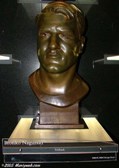Dates
Born November 3, 1908, Rainy River, Ontario, Canada
Died January 7, 1990, International Falls, Minnesota
Marriage
Eileen Kane, December 28, 1936
Kids (six)
Bronko Jr.
Biography
Bronislau ‘Bronko’ Nagurski was born to Polish Ukrainian immigrants in Rainy River in Ontario in 1903. Moving to International Falls in 1912, he grew up working on the family farm and delivering grocieries for the family’s store.
In 1926, he was recruited to play football for the University of Minnesota. Legend is that coach Doc Spears was searching for a player who lived in Minnesota’s north woods, and became lost on the unmarked dirt roads. He came across a young man plowing a field without the aid of a horse, and asked directions. The young man picked up the plow, and quietly pointed the way, and Spears signed him on the spot.
At Minnesota, Nagurski played tackle and end in his first season on varsity in 1927, before being moved to fullback in 1928. At 6 foot 2, 220-230 pounds, Bronko was bigger than virtually everyone else on the field, and would tend to crush opponents, whether running with the ball, blocking, or playing defense. In 1929, he became the only player to ever be named All-American at two positions in the same season, tackle and fullback.
Bronko Nagurski with the BearsIn 1930, Bronko signed with George Halas and the Chicago Bears for $5,000, and quickly became a star, leading the team to and NFL Championship in 1932 with a jump pass to Red Grange, and again in 1933 with two more touchdown passes.
 In 1938, after Nagurski’s first son, Bronko Jr., was born, he asked Halas for a raise to $6,500. Halas, who had cut Bronko’s salary earlier in his career due to the depression, refused, so Bronko retired from football, and took up wrestling full time (he had been wrestling on the side to supplement his income.
In 1938, after Nagurski’s first son, Bronko Jr., was born, he asked Halas for a raise to $6,500. Halas, who had cut Bronko’s salary earlier in his career due to the depression, refused, so Bronko retired from football, and took up wrestling full time (he had been wrestling on the side to supplement his income.
Bronko became a World Heavyweight Champion three times in his wrestling career, winning one title in 1937, and the NWA Title in 1939 and 1941. He retired after the third title reign, and returned to Minnesota to farm full time.
In 1943, Bronko received a letter from the Bears, asking him to come out of retirement, as they were short of players due to World War II. He agreed, on the condition that he be allowed to arrive after the harvest, and that he only play tackle, doubting he could be effective as a running back. He had a strong season as a blocker and on defense, but trailing in the regular season finale, and needing to beat the arch rival Chicago Cardinals to advance to the league championship, Bronko returned to fullback and racked up 84 yards in one quarter, leading the team to victory. He scored one more touchdown in their championship game win over Washington, and then retired for good.
By 1946, Bronko returned to professional wrestling part time, a profession he continued until 1960. In 1957, he sold the family farm, and in 1960 purcahsed a gas station in International Falls, which he operated with his sons. Preferring to live a quiet, ordinary life, he also worked as a fishing guide.
 In 1951, he was elected one of the charter members of the College Football Hall of Fame, and in 1963 became a charter enshrinee of the Pro Football Hall of Fame. He was name Minnesotan of the year in 1978, although he had to be convinced to accept the award, and in 1979 the University of Minnesota retired his #72 jersey.
In 1951, he was elected one of the charter members of the College Football Hall of Fame, and in 1963 became a charter enshrinee of the Pro Football Hall of Fame. He was name Minnesotan of the year in 1978, although he had to be convinced to accept the award, and in 1979 the University of Minnesota retired his #72 jersey.
After he passed away in 1990, he was honored by the Football Writers Association in 1993 by having his name attached to college football’s Defensive Player of the Year trophy. Also in 1993, the only (known) museum dedicated to an individual football player opened, when the Bronko Nagurski Museum opened as a wing of the Koochiching County Historical Society in International Falls.
Bronko Nagurski on the web…
BronkoNagurski.com
Related Manlyweb Content
Bronko Nagurski at the Pro Football Hall of Fame.
George Halas Biography.
Recent Comments